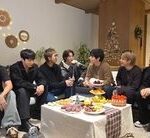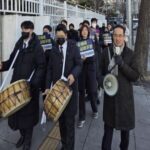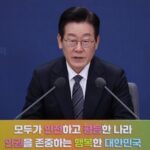‘Why is North Korea doing this?’
This is a question we often hear these days, whether in public or private settings. While various interpretations regarding North Korea’s intentions are possible, this article attempts to explain it from the perspective of ‘regime cohesion’.
There is an abundance of interpretations that argue ‘The North Korean regime deliberately exacerbates crises to divert the dissatisfaction of its citizens due to food shortages and economic difficulties and promote regime cohesion’. Especially since the Yoon Suk-yeol government took office, key government officials have been actively promoting this argument.
I also believe that the main motive behind North Korea’s recent provocative speech and the declaration of “hostile two countries” originated from the intention of regime cohesion. However, I completely differ in the basis for this. As I will discuss later, I believe that North Korea is making considerable achievements in recent food production and economic growth.

From Dual Identity to Establishing National Identity
Therefore, we need to view regime cohesion from a different perspective. That is the change in national identity. Various changes are fundamental, diverse, and highly interconnected. First, it aims to establish an identity as an ‘irreversible nuclear power’, completely shedding the perspective that ‘the denuclearization of the Korean peninsula is the teaching of Kim Il-sung and Kim Jong-il’.
The way to justify this is to fundamentally re-establish the South-North and U.S. policies. It seeks to transform the inter-Korean relationship from a ‘special relationship aiming for unification’ to ‘two countries at war and hostile’.
The same goes for the relationship with the U.S. North Korea, which used to be an anti-American country that ‘desperately wanted to be pro-American’, wants to give up being pro-American and lead an anti-American alliance. It propagandizes that nuclear armament is essential to deter war against the U.S.-South Korea alliance that is eagerly looking for a North Korean invasion, and to seek victory if war breaks out.
Then, what happens to the people’s lives and economy if North Korea gives up the South-North and North-U.S. relations? Economic considerations were a major reason why the past North Korea valued South-North and North-U.S. relations. Aid to North Korea and inter-Korean economic cooperation were a way out for North Korea, which was suffering from extreme food and economic difficulties.
The North-U.S. relationship didn’t need to be mentioned. It was seen as impossible to improve people’s lives and economic development without resolving the U.S.-led sanctions against North Korea. Therefore, in the past North Korean media, we often encountered remarks from North Korean residents such as ‘If the North-U.S. relationship improves, we can live well too’. But it has been markedly different since 2020. It is clearly defining its economic identity as ‘Let’s break through the sanctions against North Korea with self-reliance and self-sufficiency’.
Then, will this change in identity help with regime cohesion? The Kim Jong-un regime believes so. It believes that overcoming the confusion of the ‘dual identity’ of the past and firmly establishing the identity of “our socialism” will help maintain the regime and cohesion.
Here, the dual identity is as follows. The duality of worrying about absorption unification while promoting unification as a national event, the duality of not being able to shake off the necessity of nuclear armament while claiming that denuclearization is teaching, the duality of wanting to become pro-American while being anti-American, the duality of wanting sanctions to be resolved while engaging in behavior that triggers sanctions, etc.
The peak of this confusion about dual identity was in 2019. With the historic Korean Peninsula peace process led by Moon Jae-in, Trump, and Kim Jong-un in 2018, not only the North Korean regime but also the expectations of the residents greatly increased.
However, 2019, which was believed to be the year of fruition, ended up being a year of frustration. The U.S. demanded unilateral denuclearization close to North Korea’s disarmament, thinking it had agreed to ‘the denuclearization of the Korean Peninsula’. The expected sanctions were not eased but rather strengthened. The U.S.-South Korea joint training, which Trump promised to stop, resumed. The Moon Jae-in government, which had agreed to pursue “gradual disarmament”, embarked on a record-breaking military buildup.
Experiencing this, Kim Jong-un sent a heartfelt letter to Trump in early August 2019. He wrote, “Don’t treat me like a fool who only gives and doesn’t receive anything.” He also called the Moon Jae-in government a fool. In particular, he openly expressed the confusion he and his people experienced, saying, “It is very difficult for me and my people to understand your and South Korean authorities’ decisions and actions.” And then he decided to put an end to the era of dual identity.
In this situation, when the Yoon Suk-yeol government, which clearly defined its hostile policy toward North Korea, appeared, the Kim Jong-un regime considered it an opportunity to strengthen the politics of identity. The discourse of Kim Yo-jong, vice director of the Labor Party, which came out on January 2 this year, also supports this analysis. The gist of the discourse, filled with a mocking tone, expressed ‘betrayal’ of the Moon Jae-in government, which confused them with ‘speech-action inconsistency’, and ‘gratitude’ to the Yoon Suk-yeol government, which clearly defined hostility toward North Korea with ‘speech-action consistency’, thus establishing their opposition.
Even if it tries to establish identities such as a nuclear power, anti-American and anti-Korean and pro-China and pro-Russian, and a strategic country, if its commitment to achieve people’s lives and economic development through self-reliance and self-sufficiency does not yield results, there is a limit to regime cohesion. However, it seems that North Korea is making considerable achievements in these areas.
‘Invisible Gorilla Experiment’
In 1999, Daniel Simons and Christopher Chabris of Harvard University in the United States conducted an interesting experiment. They asked 36 subjects to count the number of times three people in white clothes and three people in black clothes passed a basketball to each other in a video. Most of the subjects, who were focused on the screen, got the answer right.
But there was another question. “Did you see a person dressed as a gorilla beating his chest and crossing the stage for 5 seconds in the video?” Surprisingly, about half said they didn’t see it. This is the ‘Invisible Gorilla Experiment’ that proves the confirmation bias phenomenon that people usually only see what they want to see.
What about the outside view of North Korea? The North Korea familiar to the outside world is mainly consumed as an existence that ‘sticks to nuclear and missile development even though it is poor, starving, and internationally isolated’. So, like the subjects of the ‘Invisible Gorilla Experiment’ who accurately counted the number of times the basketball was passed, they know exactly how many times North Korea has launched missiles.
But North Korea does not only make nuclear weapons and missiles and shoot missiles. There are also noteworthy changes in people’s lives such as economic development, and the diplomatic environment. However, the outside world is not properly capturing the changed North Korea because it only pays attention to North Korea’s nuclear and missile issues.
The view of North Korea’s food and economic issues is representative. We have heard countless diagnoses such as “There are many starving people” or “The economic difficulties are getting serious, posing a threat to the regime”. North Korea has indeed been in such a situation in the past. However, since the Kim Jong-un regime, food shortages and economic difficulties have begun to ease little by little, and the trend has been accelerating since the 8th Party Congress in 2021.
Yet, the outside world either doesn’t know this, doesn’t believe it, or pretends not to know. Sometimes they selectively choose or distort information about North Korea according to their political needs.
In this regard, it is necessary to pay attention to the results of the 9th Labor Party Plenary Meeting. As mentioned in the previous article, it said that it had exceeded the ’12 peaks’, including grain production (3% higher than the target), which it had set as a goal for 2023, and especially announced that the domestic gross production in 2021∽2023 increased “1.4 times” compared to 2020. If this is true, it means that North Korea has achieved an economic growth rate of nearly 12% annually over the past three years.
It is impossible to verify this from the outside, but it doesn’t seem very likely that the Kim Jong-un regime spread ‘fake news’ domestically and internationally. For reference, I was also able to hear from a Chinese North Korean informant I met in late December last year that ‘North Korea’s food situation and economic situation are noticeably improving’.
In this way, it is not an exaggeration to say that North Korea is becoming a ‘nuclear power escaping poverty’ from a ‘poor nuclear power’. This means that the North Korean policy of the U.S., Japan, and South Korea must fundamentally change.
For the past North Korea, the pursuit of economic development and the status of a nuclear power had a strong either-or nature. The ‘Byungjin Line of Economic Construction and Nuclear Force Construction’ declared in March 2013 and declared its end in April 2018 was transitional. However, after going through 2019, North Korea has turned to the position that the two can be concurrent rather than either-or.
What is important here is the cost-benefit relationship that this judgment brings. If the food and economic difficulties worsened due to the choice of the Kim Jong-un regime, the possibility of North Korea re-emerging as a subject of aid or sanctions would have relatively increased. But if we look at various circumstances and information, we can see that ‘Byungjin Line 2.0’ is yielding considerable results. This tells us that we need to break away from the inertia of looking at North Korea as a subject of aid or sanctions.
By. Woo Sik Jung















Most Commented